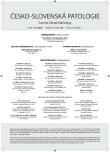Pathology of non-reflux esophagitides
Authors:
Ondřej Daum; Magdaléna Dubová; Marián Švajdler
Authors‘ workplace:
Bioptická laboratoř, s. r. o., Plzeň
; Šiklův ústav patologie LF UK a FN Plzeň
Published in:
Čes.-slov. Patol., 52, 2016, No. 1, p. 23-30
Category:
Reviews Article
Overview
The topic of non-reflux esophagitides is partially hidden in the shadow cast by the huge and modern entity of gastroesophageal reflux disease. Histological investigation alone is often insufficient to reach the correct diagnosis without a correlation of the microscopic picture with clinical presentation, endoscopic gross appearance, personal and pharmacological history of the patient, results of hematological, serological, immunological and microbiological examinations. Due to their low-prevalence, individual types of non-reflux esophagitides are not routinely encountered in routine biopsies. Furthermore, the plethora of etiological agents present with only a limited range of reaction patterns, and thus a single histological picture may be common for more agents. Conversely, one cause may be associated with more morphological patterns. Due to these circumstances the pathological diagnostic management should follow a settled algorithm to prevent an inadequate narrowing of the histopathologist´s view. Histologic findings forming the base of this algorithm include distribution and type of inflammatory infiltrate, appearance of epithelial changes, and (in some cases) even the presence of causative agent in histological slides.
Keywords:
esophagus – esophagitis – mycotic – HSV – CMV – eosinophilic
Sources
1. Chandan VS, Murray JA, Abraham SC. Esophageal lichen planus. Arch Pathol Lab Med 2008; 132(6): 1026-1029.
2. Rubio CA, Sjodahl K, Lagergren J. Lymphocytic esophagitis: a histologic subset of chronic esophagitis. Am J Clin Pathol 2006; 125(3): 432-437.
3. Purdy JK, Appelman HD, Golembeski CP, McKenna BJ. Lymphocytic esophagitis: a chronic or recurring pattern of esophagitis resembling allergic contact dermatitis. Am J Clin Pathol 2008; 130(4): 508-513.
4. Veits L, Drgac J, Rieker RJ. Lymphozytare osophagitis: eine ausschlussdiagnose in der diagnostik chronischer osophagitiden. Pathologe 2013; 34(2): 105-109.
5. Feiden W, Borchard F, Burrig KF, Pfitzer P. Herpes oesophagitis. I. Light microscopical and immunohistochemical investigations. Virchows Arch A Pathol Anat Histopathol 1984; 404(2): 167-176.
6. Greenson JK. Macrophage aggregates in cytomegalovirus esophagitis. Hum Pathol 1997; 28(3): 375-378.
7. Greenson JK, Beschorner WE, Boitnott JK, Yardley JH. Prominent mononuclear cell infiltrate is characteristic of herpes esophagitis. Hum Pathol 1991; 22(6): 541-549.
8. Zidar N, Ferkolj I, Tepes K, et al. Diagnosing cytomegalovirus in patients with inflammatory bowel disease-by immunohistochemistry or polymerase chain reaction? Virchows Arch 2015; 466(5): 533-539.
9. Abraham SC, Bhagavan BS, Lee LA, Rashid A, Wu TT. Upper gastrointestinal tract injury in patients receiving kayexalate (sodium polystyrene sulfonate) in sorbitol: clinical, endoscopic, and histopathologic findings. Am J Surg Pathol 2001; 25(5): 637-644.
10. Dellon ES, Gonsalves N, Hirano I, Furuta GT, Liacouras CA, Katzka DA. ACG clinical guideline: Evidenced based approach to the diagnosis and management of esophageal eosinophilia and eosinophilic esophagitis (EoE). Am J Gastroenterol 2013; 108(5): 679-692.
11. Lee S, de Boer WB, Naran A, et al. More than just counting eosinophils: proximal oesophageal involvement and subepithelial sclerosis are major diagnostic criteria for eosinophilic oesophagitis. J Clin Pathol 2010; 63(7): 644- 647.
12. Yan BM, Shaffer EA. Primary eosinophilic disorders of the gastrointestinal tract. Gut 2009; 58(5): 721-732.
13. Abdullah BA, Gupta SK, Croffie JM, et al. The role of esophagogastroduodenoscopy in the initial evaluation of childhood inflammatory bowel disease: a 7-year study. J Pediatr Gastroenterol Nutr 2002; 35(5): 636-640.
14. Feagans J, Victor D, Joshi V. Crohn disease of the esophagus: a review of the literature. South Med J 2008; 101(9): 927-930.
15. Sakuraba A, Iwao Y, Matsuoka K, et al. Endoscopic and pathologic changes of the upper gastrointestinal tract in Crohn’s disease. Bio- Med research international 2014; 610767.
16. Noffsinger A, Fenoglio-Preiser CM, Maru D, Gilinsky D. Diseases of the esophagus. In: King DW, Sobin LH, Stocker JT, et al., eds. Atlas of nontumor pathology, Fascicle 5 - Gastrointestinal diseases (1 ed). Washington, DC: American Registry of Pathology; 2007: 91-122.
17. Bennett AE, Goldblum JR, Odze RD. Inflammatory disorders of the esophagus. In: Odze RD, Goldblum JR, eds. Surgical pathology of the GI tract, liver, biliary tract, and pancreas (2nd ed). Philadelphia, PA: Saunders/ Elsevier; 2009: 231-267.
Labels
Anatomical pathology Forensic medical examiner ToxicologyArticle was published in
Czecho-Slovak Pathology

2016 Issue 1
Most read in this issue
- Serrated adenomas and carcinomas of the colon
- Morphology of the gastroesophageal reflux disease
- Follicular and mantle cell lymphoma diagnosed in biopsies of gastroenterocolic region
- Skin cell response after jellyfish sting
